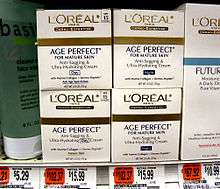Anti-aging cream
Anti-aging creams are predominantly moisturiser-based cosmeceutical skin care products marketed with the promise of making the consumer look younger by reducing, masking or preventing signs of skin aging. These signs are laxity (sagging), rhytids (wrinkles), and photoaging, which includes erythema (redness), dyspigmentation (brown discolorations), solar elastosis (yellowing), keratoses (abnormal growths), and poor texture.[1]

Despite great demand, many anti-aging products and treatments have not been proven to give lasting or major positive effects. One study found that the best performing creams reduced wrinkles by less than 10% over 12 weeks, which is not noticeable to the human eye.[2] Another study found that cheap moisturisers were as effective as high-priced anti-wrinkle creams.[3][4] A 2009 study at Manchester University, funded by the manufacturer of the cream, showed that a proprietary blend of ingredients had a positive effect after six months of daily application when extrapolated to a twelve month basis of comparison.[5][6] The statistical methods used to show this have been criticized.[7]
Traditionally, anti-aging creams have been marketed towards women, but products specifically targeting men are increasingly common.[8]
Ingredients
Anti-aging creams may include conventional moisturising ingredients. They also usually contain specific ingredients claimed to have anti-aging properties, such as:
- Retinoids (for instance, in the form of retinyl palmitate). In various formulations it has been shown to reduce fine lines and pores.[9]
- Epidermal growth factor, to stimulate cell renewal and collagen production in the skin, and strengthen elasticity and structure. In various research epidermal growth factor has been shown to reduce fine lines, wrinkles and sagging.[10] It also has healing (wounds and burns) and anti-inflammatory properties when applied to skin.[11]
- Equol[12][13][14][15][16][17]
- Alpha hydroxy acids (AHAs) and beta hydroxy acids or other chemical peels. These help to dissolve the intracellular "glue" that holds dead cells together on the skin. The use of this type of product on a daily basis gradually enhances the exfoliation of the epidermis. This exposes newer skin cells and can help improve appearance. AHAs may irritate some skin, causing redness and flaking.
- Peptides, such as acetyl hexapeptide-3 (Argireline), Matryxil, and copper peptides.
- Coenzyme Q10
- Anti-oxidants are substances that may protect cells from the damage caused by unstable molecules known as free radicals.[18] The studies so far are inconclusive, but generally don’t provide strong evidence that antioxidant supplements have a substantial impact on disease.
- Sunscreens provide a high level of UVA protection against the effects of UVA radiation, such as wrinkles.[19][20]
- Vitamin C[21]
References
- Alexiades-Armenakas MR, et al .J Am Acad Dermatol. 2008 May;58(5):719-37; quiz 738-40.
- "Wrinkle creams - Nakin Anti-Ageing Skincare". Nakinskincare.com. 2016-07-28. Retrieved 2019-02-14.
- "Anti-wrinkle eye creams - Archive - Which? Home & garden". Which.co.uk. 2009-08-20. Retrieved 2012-02-14.
- Smithers, Rebecca (2009-08-20). "One in the eye for anti-wrinkle creams | Money | guardian.co.uk". Guardian. Retrieved 2012-02-14.
- "Anti-aging cosmetic reduced wrinkles in clinical trial". Eurekalert.org. 2009-04-28. Retrieved 2012-02-14.
- Watson, REB; Ogden, S; Bowden, JJ; Bastrilles, JY; Long, SP; Griffiths, CEM (August 2009). "A cosmetic 'anti-ageing' product improves photoaged skin: a double-blind, randomized controlled trial". Br J Dermatol. 161 (2): 419–426. doi:10.1111/j.1365-2133.2009.09216.x. PMC 2774146. PMID 19438432.
- Bland, Martin (19 November 2009). "Keep young and beautiful: evidence for an "anti‐aging" product?". Significance. 6 (4): 182–183. doi:10.1111/j.1740-9713.2009.00395.x.
- "Drawing a line under men's wrinkles". BBC News Magazine. 2005-04-19. Retrieved 2012-07-18.
- "Archderm.ama-assn.org". Archderm.ama-assn.org. 2007-05-01. doi:10.1001/archderm.143.5.606. Retrieved 2012-02-14. Cite journal requires
|journal=(help) - Journal of Controlled Release, April 2007, pages 169–176; Journal of Burn Care and Rehabilitation, March–April 2002, pages 116–125; and Journal of Dermatologic Surgery and Oncology, July 1992, pages 604–606
- Skin Pharmacology and Applied Skin Physiology, January–April 1999, pages 79–84
- Lephart, Edwin D. (November 2013). "Protective effects of equol and their polyphenolic isomers against dermal aging: Microarray/protein evidence with clinical implications and unique delivery into human skin". Pharmaceutical Biology. 51 (11): 1393–1400. doi:10.3109/13880209.2013.793720. ISSN 1388-0209.
- Magnet, U.; Urbanek, C.; Gaisberger, D.; Tomeva, E.; Dum, E.; Pointner, A.; Haslberger, A.G. (October 2017). "Topical equol preparation improves structural and molecular skin parameters". International Journal of Cosmetic Science. 39 (5): 535–542. doi:10.1111/ics.12408. PMID 28574180.
- Equol – a Topically Applied Phyto-Oestrogen Improves Skin Characteristics Urbanek C, Haslberger A, Hippe B, Gessner D, Fiala H, Equol – a Topically Applied Phyto-Oestrogen Improves Skin Characteristics. Global ingredients and Formulations Guide 2016
- Lephart, Edwin (2018-01-29). "Equol's Anti-Aging Effects Protect against Environmental Assaults by Increasing Skin Antioxidant Defense and ECM Proteins While Decreasing Oxidative Stress and Inflammation". Cosmetics. 5 (1): 16. doi:10.3390/cosmetics5010016. ISSN 2079-9284.
- Lephart, Edwin D. (November 2013). "Protective effects of equol and their polyphenolic isomers against dermal aging: Microarray/protein evidence with clinical implications and unique delivery into human skin". Pharmaceutical Biology. 51 (11): 1393–1400. doi:10.3109/13880209.2013.793720. ISSN 1388-0209.
- Reeve, Vivienne E.; Widyarini, Sitarina; Domanski, Diane; Chew, Elaine; Barnes, Karen (2005). "Protection Against Photoaging in the Hairless Mouse by the Isoflavone Equol". Photochemistry and Photobiology. 81 (6): 1548–1553. doi:10.1562/2005-07-26-RA-624. ISSN 1751-1097.
- "Antioxidants: Beyond the Hype | The Nutrition Source | Harvard T.H. Chan School of Public Health". www.hsph.harvard.edu. Retrieved 2016-02-13.
- "Sunscreens Explained". SkinCancer.org. Retrieved 2012-02-14.
- Draelos M.D., Zoe Diana. "Article". Plastic and Reconstructive Surgery. Retrieved 5 March 2015.
Sunscreen is the most biologically active antiaging ingredient in skin care products, but the antiinflammatory and antioxidant effects of botanicals possess tremendous marketing appeal.
- Telang, PS (2013). "Vitamin C in dermatology". Indian Dermatol Online J. 4 (2): 143–6. doi:10.4103/2229-5178.110593. PMC 3673383. PMID 23741676.